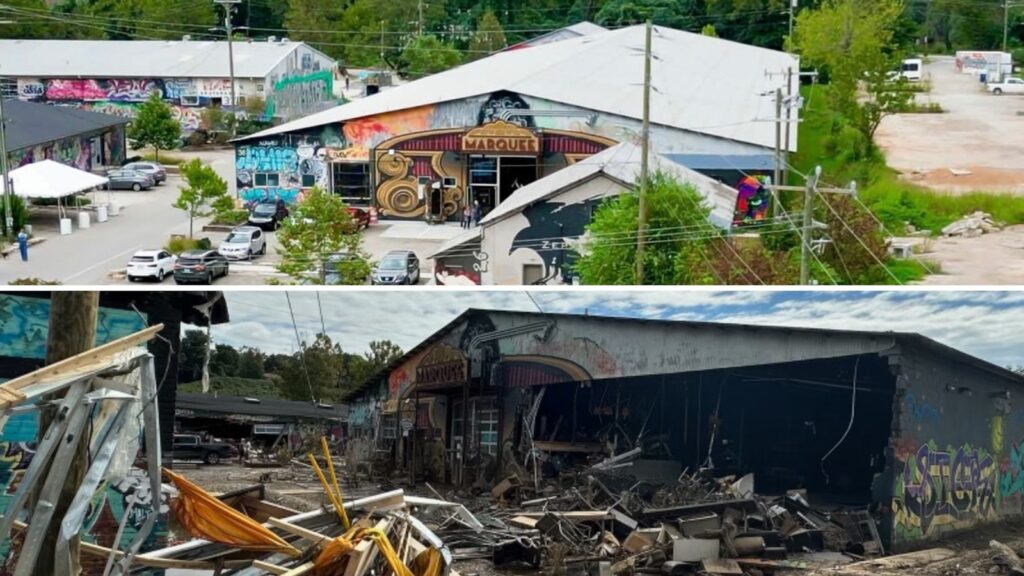I’m collecting links for the print-on-demand stores for artists around Asheville/ Buncombe County/ Western North Carolina to share and promote. The goal is to support the local artists who were so heavily impacted without burdening them with order fulfillment.
When I’m feeling uninspired, I’ll wander around the Marquee in the River Arts district. It is a huge warehouse split up into hundreds of stalls and areas for local makers, artisans, antiquers, and collectors to show and sell their wares. Many artist rent out an 8X12ish wall space to hang their original pieces and host a few racks of affordable prints, stickers, books, or whatever else they can create and sell. Rummagers and antique collectors will put together a chaotic yet organized looking tableau of goods from another era — everything speaks to each other in a slightly different language.
At the front of the Marquee is a bar. Grab a drink and start wandering. There is no rhyme or reason or order to any of it. But there are at least a dozen things here that are perfect for you. And even if you somehow walk away empty handed, your mind will be packed with novelties and new ideas.
Well, at least, that’s what it used to be.

On Friday I stood atop the River Link bridge that spans the French Broad River between West Asheville and the River Arts District and watched the entirety of the inventory within the walls of the Marquee float down the flood waters caused by Hurricane Helene.
Mid mod furniture, carved wood statues, framed paintings. Some artists have lost absolutely everything — their studio washed out, their inventory gone.
We watched as the empty shipping containers that were used as graffiti canvases crashed into power poles and trees. We watched a winery float by, piece by piece. Then a brewery. Then a house. Then a trailer for an 18-wheeler. Brick structures collapsed. Second Gear — a local, independent consignment shop for outdoor equipment (and a businesses that seemed to single-handedly supply summer tourists with all the river-floating gear you could need) flooded to its ceiling. Then, as the waters receded, the walls caved in and fell.
A total loss.
And that’s just what we could see from the bridge. The river swelled twenty and thirty feet, breaking over its banks. Entire towns are gone. The Old Marshall Jail — long since renovated into a boutique hotel along the banks of the French Broad — had featured a gauge on the side of their building to remind people of the last great flood. 22 feet then. The gauge reached 31 on Friday. The town hall and county seat, standing up the hill and over everything, took on water.
Look up stories about Chimney Rock and Swannanoa — if you have the stomach for it.
A few months ago these stickers started popping up all over town.

Every trip to the Marquee meant I was bringing home a few prints or antique books that would live somewhere in my house. Our home is lousy with local art — we don’t have enough wall space. I stash it in portfolio folders or send it out to friends or give it away when I can.
The point I’m trying to make, if there is a point to make, is this: The flooding from Hurricane Helene has destroyed a great deal of the independent artisan community that makes this town what it is. I only named a fraction of a fraction of the impacted areas and businesses. The short of it is this: if it was within 20 vertical feet of a river, it was damaged if not destroyed.
On Saturday we go hunting for some kind of cell connection and a few groceries — just enough to let people know we were OK, just enough to hunker down for a bit. The downtown hotels — largely unaffected by the storm — had open wifi networks that hundreds of people stood on the sidewalk to use. Across the street, the French Broad Coop was open — cash only, no refrigerated/ frozen/ perishable foods — with extensive lines and exhausted workers.
We try a quick stop to the other grocery stories. Harris Teeter is open, line wraps around the parking lot, but they are sold out of water. Whole Foods is closed, still without power. An employee there tells me that they aren’t opening and the staff has been called into throw away all of the spoilage. “Over a million dollars worth of food,” she says, heartbroken.
I ask her if I can just give her some cash to buy water. No, she says. No transactions at all. We just can’t do it.
I’ve ranted before about how it is baffling that a corporation with trillions of dollars of technology and tech development under its belt can’t seem to get a few simple things figured out. How can a company that can get anything from one side of the country to the other in under two days struggle with opening up just enough to support their community.
I guess I finally have my reason to end all ties with Amazon, Whole foods, etc. Hell, even WalMart and Sam’s club were giving away pallets of bottled water to whoever needed them. Across town, we stop in at The Odd — a dive bar with a frier and flat top — they open up to cook and give away all of their food while they still can. The goal is to kill the kegs before they’re too warm to drink. The bar is dark, without power, but the gas line is still running. People are lined up around the building for a burger and fries.
As the storm passed the area got a better idea of the challenges ahead. Interstate 40 collapsed east of town — which would have been the easiest way to get supplies in and out via Charlotte. Now it was reduced to one precarious lane for emergency and search and rescue vehicles. 26 East (which really goes “south” of town) was shut down due to flooding. 26 West and 40 West into Tennessee were wrecked. For a while, Asheville was an island. Provisions to the most desperate areas were dropped in from helicopters.
Then, the water system failed. The entire city of Asheville, as of this writing (September 30, 2024) is without water. We watched our taps slow to a trickle.
More rain is on the way.
Like most places that rely on tourism for their economy, Asheville has the places everyone comes to visit because they wind up on PR circuits and “best of” lists. This is fine, whatever gets you here I’m all for. See the Biltmore and Sierra Nevada. Go for dinner at one of the three OKish steakhouses. But then, I beg of you, wander around. Not just here, but anywhere you visit. Get off the beaten path, get on the public transit (Asheville’s bus system is a dollar ($1) from end to end, which is ridiculously good). Spread the money around to those who can’t afford the national attention or ties with the food-critic with iffy taste.
What’s the other option? Will these artists and creators have reason to come back when disaster strikes? Will it be worth the rebuild? From the perspective of an artist — of course, they can’t not create. There will always be a reason to put the brush to the canvas and make something phenomenal. But is the studio space in the retrofitted warehouse area worth the cost?
Will you visit? Would you?


